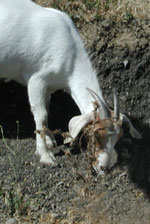Threats to Birds - Feral Goat (Capra hircus)
Overview
Feral goats can have particularly devastating impacts when introduced into fragile ecosystems such as islands. Goats eat anything in their path, leaving once-vegetated lands exposed to erosion and invasive plants. Goats eat plants that are avoided by sheep or cattle, increasing impacts on native plants and animals. They easily become feral and can spread disease to native animals such as rabies and foot and mouth disease. Goats can live in nearly all habitats from low to high elevations. Considered the single most destructive herbivore introduced to the islands of the world. Originally brought to the Hawaiian islands by Captain James Cook in 1778, goats were introduced to other islands as a food reserve for shipwrecked sailors.
Description
Goats can breed twice/year and often bear twins. A female goat is capable of breeding at the age of 6 to 7 months.
Birds Affected
Endemic Hawaiian birds including Hawaiian Goose (Nene) and Hawaiian Petrel; Laysan Albatross; Newell’s Shearwater; forest birds due to loss of forest habitat.
Control
Hunting alone will not affect the populations. From 1920 - 1970, approximately 70,000 feral goats were removed from Hawai'i Volcanoes National Park with no noticeable effect. In Hawai'i, New Zealand and Australia, radio-collared “Judas” goats are released into an inaccessible area known to have feral goats. The Judas goat will join the feral goats allowing biologists to locate the herd. Hunters are then dispatched to the area by helicopters. The Judas goat can be allowed to escape and the process is repeated until feral goats are no longer encountered. Fencing to keep goats out of sensitive areas has also worked well. |
